#hemolytic
Note
I want to clarify that my intention is not to be unkind or instruct you on how to handle your emotions. However, discussing self-harm in the manner you do can be highly distressing, and using threats of self-harm to manipulate others, even if it feels valid at the moment, is a concerning and manipulative behavior. Please seek help.
Trigger warnings for body horror, death, illnesd and blood and gore.
Okay this has been sitting in my box for a bit and I was very concerned with just what the unholy hell you were talking about but then I realized what "bleed to death if they're mean to me" must sound like outside of my own head.
In a very abstract way, you're right. It is self harm but it's an autoimmune disorder. It's my immune system misfiring and hurting me, not a mental illness manifestation. Think of it as a friendly fire incident. The body mistakes friendly cells for for bacteria and attacks them. For me, this is hemolytic anemia. Hemolytic anemia isn't common, only making up about 5% of all anemias diagnosed, but considering how misdiagnosed it is and how common anemia is, it's something that should be talked about more.
So hemolytic anemia as a bodily process is somewhat common but mine as originates from a specific genetic pattern I inherited from my French Canadian parent is pretty rare and dramatic. But the general gist is that red bloodcells carry oxygen and white blood cells are your immune system so when I'm ill or stressed (hence the being mean to me part lol) my body copes by firing off white bloodcells to destroy my red blood cells. And without the oxygen carrying cells, oxygen can't be delivered. It can be much like normal anemia where a heavy period hinders your bloods ability to deliver oxygen and makes you tired and cold and ill.
That part you can get used too. In me however, having that rare sort and being very young and until recently an unencumbered immune system, I have gone from fine to, and I mean this in the most frank of ways, bleeding to death without opening a vein in less than an hour. I can destroy blood so fast they've rigged me up to two bags of blood at once to compensate. Not quite as fast as say, opening up a wrist in the bathtub, but considering I don't choose when it happens, it's not what anyone would consider ideal conditions to finish a degree under.
So yeah, if you're depressed, get your mental and physical health checked out! Your mental health is important! If you're feeling ill and weak and cold, see a doctor. If your piss suddenly turns black, your fingernails and lips go blue and your eyes or skin turn yellow, take your ass to the ER. This has been a PSA from your local blood sucker. Cheers!
#the ask box || probis pateo#not Hetalia#autoimmune hemolytic anemia#autoimmune diseases#spoonies#chronic illness
25 notes
·
View notes
Text
Trans radfems: Yes let's harass and suicide bait seriously ill and disabled transmascs for talking about trans people that aren't me!! No I'm not ableist, I just want disabled transmascs to die because of me!!!
#my heart rate is like#'I should probably call an ambulence' levels of dangerous rn but I know they'd just tell me to get to A&E myself because nhs#I do not feel good#I don't actually know if I'm going to be okay tbh#Yay hemolytic anemia that might kill me 🎉
2 notes
·
View notes
Text
Cells at Work fandom how are there only like two fics about AIHA it has so much angst potential why are y'all sleeping on this
#Cells at work#aiha is autoimmune hemolytic anemia btw. It's when the immune system attacks red blood cells.#...yeah see where I'm going with this-
15 notes
·
View notes
Text
lucy must be a universal recipient whew
1 note
·
View note
Text
The Global Complement Inhibitors has seen significant growth in recent years driven by rising approval and adoption of novel complement therapeutics

The Global Complement Inhibitors has seen significant growth in recent years driven by rising approval and adoption of novel complement therapeutics. Complement is part of the innate immune system that helps clear pathogens and promotes inflammation. However, excessive or uncontrolled complement activation can lead to tissue damage in several rare and common diseases. This has prompted drug developers to focus on inhibiting specific components of the complement cascade to treat various medical conditions.
Eculizumab Leads The Way In Paroxysmal Nocturnal Hemoglobinuria
The first-in-class C5 inhibitor eculizumab (Soliris), developed by Alexion Pharmaceuticals, has transformed the treatment landscape of paroxysmal nocturnal hemoglobinuria (PNH). Approved in 2007, eculizumab provides long-term haemolysis control and improves survival in PNH patients by blocking terminal complement activation. It has set the benchmark for safety and efficacy of complement therapeutics. Thanks to its pioneering work in PNH, eculizumab annual sales have consistently topped USD 3 billion. Its label also covers atypical hemolytic uremic syndrome (aHUS), Global Complement Inhibitors another rare disease where complement overactivation leads to thrombocytopenia and kidney damage.
Expanding Indications Fuel Growth Of Complement Portfolio
Building on eculizumab's success, drugmakers are pursuing broader indications for complement inhibitors. Alexion has gained approval for eculizumab in generalized myasthenia gravis (gMG), an autoimmune neuromuscular disorder caused by abnormal complement activation at the neuromuscular junction. Several late-stage trials are evaluating its potential in Guillain–Barré syndrome, Huntington's disease, multiple sclerosis, and transplant rejection. Ra Pharmaceuticals has translated its understanding of the alternative complement pathway into a C3-targeted antibody razuprotafib (RA101495). It is being tested in PNH, ischemic reperfusion injury, COVID-19, and Age-related Macular Degeneration (AMD).
Global Complement Inhibitors Enter Crowded Autoimmune Domains
Given the involvement of complement pathways in several inflammatory and autoimmune diseases, this class has expanded to crowded indications like rheumatoid arthritis (RA). Novartis acquired complementary drug developer Capella Biosciences last year primarily to develop C1s inhibitor caplacizumab (Apellis Pharmaceuticals) for autoimmune disorders. Apellis commenced two phase 3 studies of caplacizumab in generalized myasthenia gravis in 2021. Roche paid €1.25 billion upfront to acquire inflamed tissue inhibitor etavopivat (Yale University/Poxel SA), positioning it as a potential treatment for conditions like fibrosis, NASH and several inflammatory diseases including RA.
Biosimilars Intensify Cost Pressures
The commercial success of eculizumab and emergence of novel complement drugs have induced several biosimilar makers to enter the space. South Korean firm Helm entered the PNH biosimilar in 2021 with its eculizumab biosimilar HEMGENE. It is being tested for aHUS and eye diseases too. Other notable eculizumab biosimilars in development include Pfizer's PF-06882961 and Coherus' CHS-202. Intense competition from biosimilars is expected to drive down drug costs, benefiting patients but also intensifying pricing pressures on originators. Companies will need to showcase differentiated safety, efficacy or indication profile of their assets to carve a niche amid biosimilar onslaught.
Oral Options Spark Excitement
The cumbersome intravenous administration regimen of eculizumab has fuelled interest in orally-available next-generation complement drugs. Akari Therapeutics' encapsolated C5a and C5 Inhibitor nomacopan (Coversin) has completed phase 2 testing in various hematologic and renal disorders. Akari is developing nomacopan as the potential first oral treatment option for patients with PNH. Apellis' APL-9, an oral small molecule C3 inhibitor has entered phase 3 studies in geographic atrophy, an advanced form of dry AMD. Odocure Therapeutics is poised to enter human testing with its unique oral C1s modulator for autoimmune and inflammatory diseases. Widespread adoption of oral alternatives could disrupt current dynamics through improved access and adherence.
Asia Pacific Emulates Western Growth
While North America and Europe currently dominate global complement drug revenues owing to early approvals, the Asia Pacific region is demonstrating promising uptake. The high prevalence of complement-mediated diseases and increasing access to novel therapies are major drivers of growth. China, India, Japan, South Korea are recognizing complement disorders and approving innovative therapeutics, positively impacting regional sales. Alexion set up China operations in 2013 and now s eculizumab, strengthening local presence. Local biosimilar makers are expediting their entry by leveraging favourable regulatory environment in Asia. Overall, the Asia Pacific complement therapeutics is projected to expand at an impressive CAGR through 2030.
Global Complement Inhibitors have carved a unique niche in treating rare diseases and expanding to broader indications. Emerging oral drugs, biosimilars and regional growth will likely reshape the competitive landscape going forward. Though pricing pressures loom large, continued innovation around complement pathways holds promise to benefit patients worldwide.
Get more insights on this topic: https://www.ukwebwire.com/the-emerging-role-of-complement-inhibition-in-treating-various-diseases/
Author Bio
Vaagisha brings over three years of expertise as a content editor in the research domain. Originally a creative writer, she discovered her passion for editing, combining her flair for writing with a meticulous eye for detail. Her ability to craft and refine compelling content makes her an invaluable asset in delivering polished and engaging write-ups. (LinkedIn: https://www.linkedin.com/in/vaagisha-singh-8080b91)
*Note:
1. Source: Coherent Insights, Public sources, Desk research
2. We have leveraged AI tools to mine information and compile it
#Global Complement Inhibitors#Atypical Hemolytic#Uremic Syndrome#Paroxysmal Nocturnal Hemoglobinuria
0 notes
Text
Warm Autoimmune Hemolytic Anemia Treatment Market Analysis
0 notes
Text
Understanding Hemolytic Uremic Syndrome in Children
In the complicated world of children’s health concerns, gaining a deep understanding of hemolytic uremic syndrome is really important for parents. By carefully watching out for signs of illness, understanding what might cause it, and knowing how it can affect a child’s health, parents can help keep their children safe from paediatric hemolytic uremic syndrome (HUS).
0 notes
Text
You know what I hate about the internet? Sometimes people will just lazily slap a “citation” on an infographic and trust that they’ll be completely taken at their word and nobody is going to dig deeper. And it works all the time. As an example, please look at this photo someone posted to dispute my assertion that garlic can be toxic to dogs.
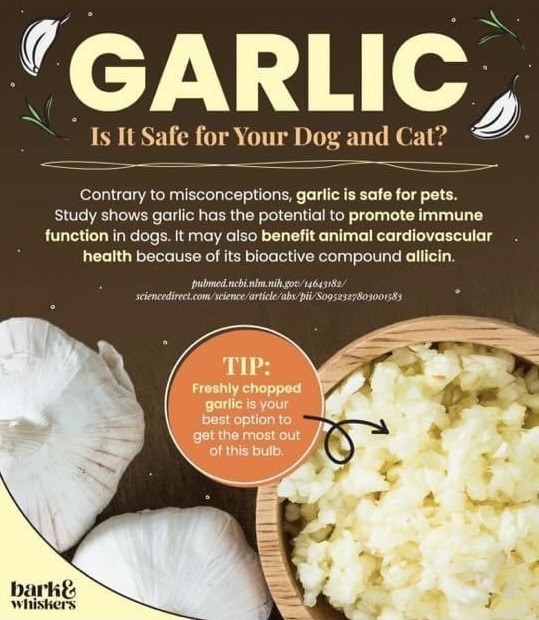
Okay well, kind of a pain to manually type in that link but obviously I am going to look into this study that is confident enough to recommend people feeding their dogs garlic. So here’s the article, kind of a weird journal choice for this graphic to reference from but looks like a legit (though 20 year old) study
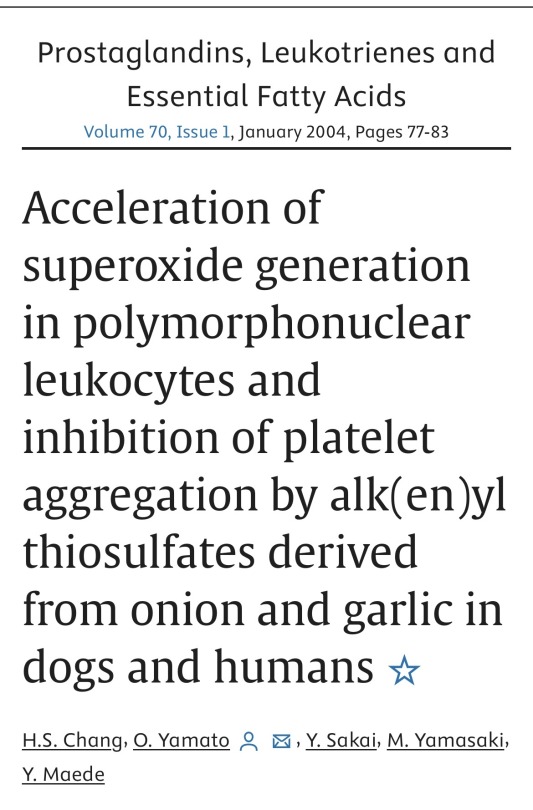
Funny thing is, almost immediately this article acknowledges that garlic can indeed be toxic to dogs. The health benefits mentioned in the graphic are referring to human health, not canine. This section is literally in the introduction of the article and one of the first things you read. Emphasis here is mine.

Crazy to me that someone would imply that this article encourages giving dogs garlic when it in fact immediately asserts that doing so has the potential to cause hemolytic anemia. The article does explore the anti-thrombotic effects of garlic components in dogs and humans, but by no means does it say that “contrary to misconceptions garlic is safe for pets”. It is dishonest to assert this in an infographic. However the creator of the image correctly assumed nobody would check, because the person who posted it took it as fact without further investigation.
I am begging you to be skeptical. Check your sources. Check their sources. Check my sources. Learn how to dig deeper and exercise that muscle as much as you can, especially on the internet. You will be absolutely shocked how much misinformation is casually stated and received as pure fact.
#scicomm#vetblr#veterinary medicine#I already know people are going to say they like giving their dogs garlic and will continue to do so- whatever pls just don’t tell me 😭#sorry if the link doesn’t work for you you may need access#dogs#pets#science literacy#biology
6K notes
·
View notes
Text
Acute Hemolytic Jaundice - Blood Picture
The acute hemolytic crisis is seen in G-6-PD. deficiency, sickle cell disease, spherocytosis, mismatched transfusion and is characterized by elevation of bilirubin (unconjugated), LDH, HBDH & SGOT.
0 notes
Text
Whenever I talk about the medical neglect and ableism I've encountered as a victim of the healthcare system, there's always some cockwaffle who feels entitled to come into my inbox and make the argument of "not all doctors" while talking about how "people like them" (because it's always someone in a field of medicine who does this) are doing their best and it's really hard because so many people fake being ill to get on welfare (Yikes), but like, yeah, obviously #not all doctors, because if all doctors were negligent, bullying scum bags, I'd be dead.
But here's the thing: while I truly believe that the majority of doctors are doing their best in a system stacked against them and their patients, their presence does not negate the mass harm caused by the bad ones. And there are far more bad ones than you realize.
Fuck, John Oliver literally did a segment on this last week:
youtube
Yes, the truly bad, malicious doctors are in the minority. Most are just horrifically burned out and fighting a losing battle against a system, killing both them and their patients through a lack of funding and resources and profound overwork.
But the malicious ones do exist, and they will go out of their way to harm patients who don't kowtow to them.
I almost lost my life because when I was in my early twenties, I told a doctor I didn't think she was listening to me, and I disagreed with her assessment of my mental health (she was not a mental health doctor, and I was there for heart palpitations and chronic pain). She retaliated by putting "non-compliant" in my file.
There was also a fun little "doesn't show respect" note too that lives rent-free in my head because I know I wasn't rude. I was polite. I just didn't agree with her, and my refusal to accept her off-handed comment that "you probably have bipolar or BPD" (again, I was there for heart palpitations and chronic pain) meant I was "refusing care."
I wasn't. I just refused to be slapped with a mood/personality disorder when I was there because I kept fucking fainting when I stood up.
(Spoiler alert: it was dysautonomia)
That "non-compliant" marker followed me around for years. It followed me across an ocean and effectively ensured that any doctor I saw was going to treat me like absolute dogshit because no one wants to help Difficult Patients. It wasn't until I was so undeniably ill, literally on the brink of death, that anyone helped me.
I'm alive because of a good doctor. And all the good ones that came after him because of him.
So, I know they exist. You don't have to tell me that.
But I really fucking need you to acknowledge the bad ones and that you're part of a system with a long, long history of abusing minorities and vulnerable people. I need you to acknowledge that because it's the only way we're going to survive this godforsaken nightmare and make things better.
So yeah, #notalldoctors, but if you feel the need to say that because someone talking about being literally left to die by the medical system hurts your feelings, I'm going to have to ask you to take a step back and ask yourself if you're going into medicine for the right reasons.
Namely: do you want to help people, even the "difficult" ones?
Even the ones who might disagree with you?
Even if they're on welfare?
Even if they'll never get "better" in a way that means "cured"?
Just a thought. But hey, what do I know. I'm just someone who experienced hemolytic anemia because doctors kept telling me I was anxious and needed to exercise more 🤷♀️.
#chronic health tag#medical abuse#medical neglect#medical#ableism#to all the good health care workers who follow me and leave supportive comments: I appreciate you so much#but you need to come get your fellow drs#and idk#give 'em a shake or something#Youtube
3K notes
·
View notes
Text
Me, going through my day with a constant crushing headache, struggling to breathe if I exert myself and constantly exhausted to the point of feeling like I might pass out, while my watch beeps at me every five minutes for my above 110 bpm resting heart rate: I'll go back to the doctor if it gets worse
#at least now that shark week has passed I don't feel like I'm suffocating all of the time#hemolytic anemia not pots or whatever if you try to armchair diagnose me with pots I'll steal your blood
2 notes
·
View notes
Text
Hemolytic Anemia
Hemolytic anemia is a type of anemia that is caused by the breakdown of red blood cells, an increase in hemoglobin catabolism, a decrease in hemoglobin levels, and an increase in efforts of bone marrow to regenerate products.
It has many causes that include acute and chronic disease, immune vs. non-immune mediated, intravascular or extravascular, inherited or acquired and, intracorpuscular or extracorpuscular.
A patient with anemia may present shortness of breath, weakness, fatigue and arrhythmias such as tachycardia, or can present asymptomatic.
Jaundice or hematuria are additional signs of anemia brought on by cell destruction or hemolysis.
Long-lasting symptoms may even be accompanied by lymphadenopathy, hepatosplenomegaly, or cholestasis.
Multiple organ systems in the body can be affected by hemolytic anemia.
When RBCs are destroyed, their byproducts set off a chain reaction that leads to additional complications.
It is simple to make the diagnosis of hemolysis, which is based on the presence of anemia and sustained reticulocytosis without bleeding.
Additional findings may include marrow erythroid hyperplasia, elevated LDH, free hemoglobin, and unconjugated bilirubin, as well as decreased haptoglobin, hemopexin, hemosiderinuria, and decreased SICr red cell half-life.
Depending on the severity of the illness, immediate interventions such as blood transfusions, plasmapheresis, or diuresis may be required.
When there is severe anemia, especially when there is active bleeding, blood transfusions are always the mainstay of treatment.
More specific treatment modalities may be used if hemolysis is the known cause of anemia or if no urgent intervention is required. However, depending on the cause, the treatment will always differ.
Read more at: https://medicaregate.com/hemolytic-anemia-causes-symptoms-and-treatments/

#Hemolytic Anemia#Hemolytic Anemia diagnosis#Hemolytic Anemia treatment#Hemolytic Anemia complications#Hemolytic Anemia signs and symptoms#anemia#hematology#hemoglobin
0 notes
Text

The complement system is an important part of the innate immune system that helps defend the body against infection and foreign pathogens. It consists of over 30 proteins that are produced mainly by the liver but also by other tissues such as leukocytes. When activated, the complement system works to eliminate pathogens in three ways: opsonization, inflammatory response recruitment, and direct cell lysis.
#Global Complement Inhibitors#Atypical Hemolytic#Uremic Syndrome#Paroxysmal Nocturnal Hemoglobinuria
0 notes
Text
So. As of right now, I know I was experiencing immune hemolytic anemia yesterday, which is why I needed the blood transfusion. We just don't know WHY. Like, my body just decided to start destroying itself for like. Funsies?????? The thrill?????? The whimsy of it all??????????????
59 notes
·
View notes
Text
You know what Alola has a lot of? Water. And when there’s lots of water you get lots of aquatic Pokémon. Welcome back to the series where I discuss the real-life inspirations of every aquatic, non-fish Pokémon. This time I’m covering gen VII. To see previous entries in this series see gen I part 1, gen I part 2, gen II, gen III, gen IV, gen V, and gen VI. For my previous series where I covered the origins of all fish Pokémon see here. As before, starters and legendary/mythical Pokémon will be covered in a separate series. I’ll also cover ultra beasts separately, so no Nihilego this time.
Starting things off we have Marenie and Toxapex bringing us the first echinoderms since gen I. While Staryu and Starmie were generic starfish, the Marenie line are based specifically on the crown-of-thorns starfish.
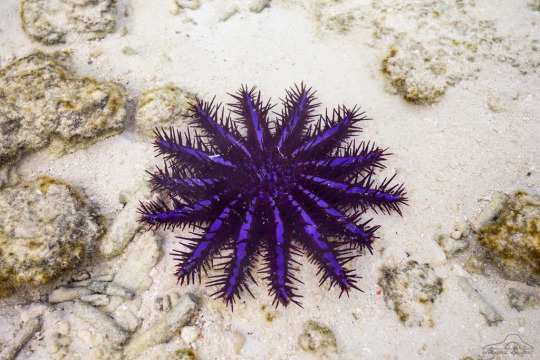
(image: a crown-of-thorns)
These are large starfish covered with venomous spines. The spines are used for defense as they (and the starfish’s other tissues) are filed with a chemicals called saponins. While there is no mechanism for injecting venom, any animal punctured by a spine will get the venom in the wound. It is hemolytic, causing destruction of red blood cells, which can lead to the injured animal suffocating or bleeding out. In addition, the spines are brittle and can break off and get stuck in a wound. In humans, the venom can cause sharp, stinging pains, persistent bleeding, and swelling and nausea for up to a week after the sting. The persistent nature of the pain and hemolysis may be the basis for the line’s signature ability “Merciless”. The other big feature of the crown-of-thorns is its diet. They feed on coral polyps by everting their stomachs onto coral and digesting them externally. This is why the line are specifically stated to prey on Corsola. Too many crown-of-thorns in one coral reef can badly damage it, hence why Toxapex is said to leave a trail of Corsola horns in its wake. Toxapex also takes influence from the hā’uke’uke or helmet urchin, a species found in Hawaii that is shaped very similar to Toxapex’s tentacles when they are all down.

(image: a hā’uke’uke)
Dewpider and Araquanid are based on diving-bell spiders. These spiders spend almost their entire lives underwater, the only species to do so. They do still need to breathe air and so used a coating of water-repelling hairs to carry a bubble of oxygen with them when they are underwater, surfacing occasionally to refresh their supply. The Dewpider line are the inverse of that: a species that can only breathe water and need to bring a bubble of water with them while they live on land. Because of this, they may also be based on sea spiders, a group of marine arthropods that look very similar to spiders. This origin is more noticeable with Araquanid, which has the skinny body and long legs of sea spiders. In both species, the bubble over the head is based on a diving helmet.
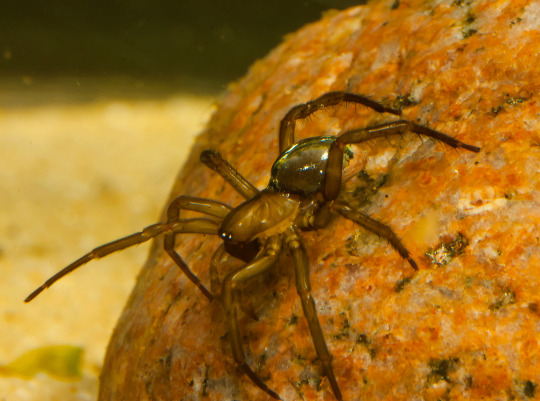
(image: a diving bell spider with its air bubble visible)
Wimpod is one of my favorite gen VII mons and its origin is complex. It is based on a variety of aquatic arthropods. Most notably it resembles an isopod while having a head similar to a trilobite.
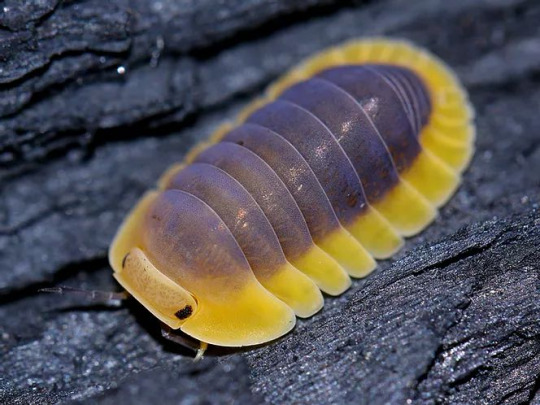
(image: a terrestrial isopod)
It also looks like a copepod, which are zooplankton that have prominent antennae. Fun fact: Plankton from Spongebob is a copepod.

(image: a copepod)
Wimpod’s behavior of fleeing at the first sign of danger is very similar to silverfish. These are insects with a similar body shape to Wimpod that are famous to coming out in the dark and fleeing once the lights come on.

(image: a silverfish)
Wimpod’s habit of eating almost anything and leading a clean path as it travels makes it effectively a living Roomba. As Golisopod, it is based on the giant isopod, a group of species that are much larger than the average isopod thanks to deep-sea gigantism. This is a phenomenon where animals living in the deep ocean become larger than their shallow-water relatives and has a number of proposed causes. The largest and most famous of the giant isopods reaches a maximum recorded length of 50 cm (19.65 in), which is still quite a bit shorter than Golisopod’s 2 m (6’7”). It is also based on samurai as its shell resembles samurai armor and some of its behavior (such as meditation) comes from samurai stories. Its ability to cleave the air in twain with its claws likely comes from classic exaggerations of a warrior’s ability. Golisopod doesn’t care much for a samurai’s code of honor though, as it will happily fight dirty and run from fights.
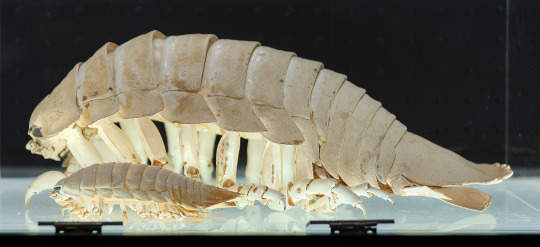
(image: preserved specimens of two giant isopod species)
Gen VII was a good one for echinoderms as coming off the hells of the starfish Marenie line we get a sea cucumber in Pyukumuku. Sea cucumbers have a pretty simple body plan, basically looking like tubes. Their most famous ability is a defense strategy some species employ where they can eject part of their guts to deter predators. In real sea cucumbers, the ejected guts will regenerate while in Pyukumuku, they can retract back into the body and even act like a hand. Sea cucumbers also have external gonads that look like strings. The fluffy tail Pyukumuku has is actually its genitals. The spikes on top might be based on sea urchins, which are relatives of sea cucumbers.
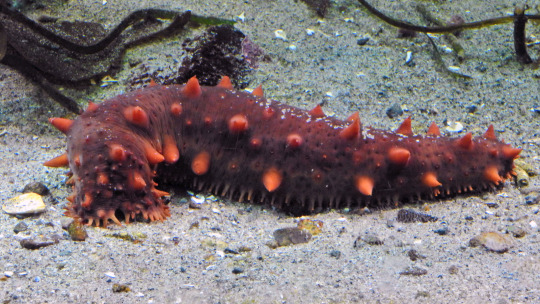
(image: a sea cucumber with similar spines to Pyukumuku)
Our final Pokemon for today is Dhelmise and it’s a weird one. An anchor and ship’s wheel bound together and possessed by the ghost of seaweed. What confuses me is that it’s a wooden anchor. It turns out wooden anchors were used at one point in early boats, but were phased out in favor of ones made of iron. Dhelmise being haunted parts of ships is reminiscent of tales of ghost ships, though on a smaller scale. The seaweed on it may be dead man’s fingers, which grows small tendrils and the name is obviously fitting for a ghost-type.
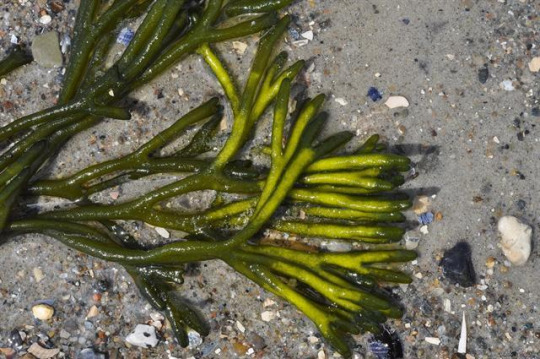
(image: dead man's fingers)
The shiny version having red seaweed could reference red tide, a type of algal bloom that can turn parts of the ocean red. Dhelmise hunts Wailord, meaning it may have been a part of a whaling ship and now the ghosts within it are carrying out their last tasks endlessly, a common trope in ghost stories. It may also reference Moby Dick’s Captain Ahab and his obsessive quest to kill the white whale.

(image: a sunken anchor from a shipwreck in Hawaii's Papahānaumokuākea National Monument)
That’s all for now. Return next time when we go to Galar.
#pokemon#pokemon biology#pokemon lore#pokemon origins#marine biology#aquatic biology#animal facts#zoology#marenie#toxapex#dewpider#araquanid#wimpod#golisopod#pyukumuku#dhelmise#starfish#crown of thorns#diving bell spider#isopods#trilobite#copepods#giant isopod#sea cucumber#echinoderm#anchor#silverfish
205 notes
·
View notes